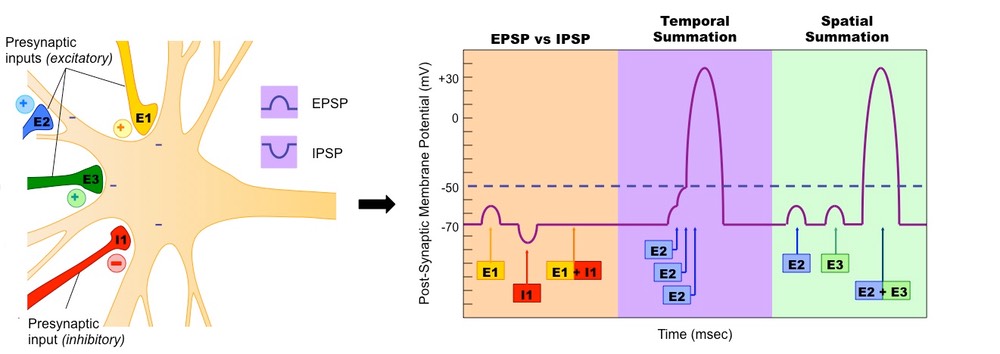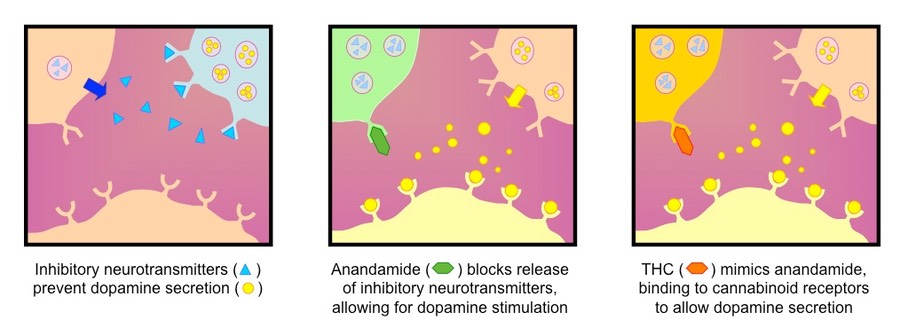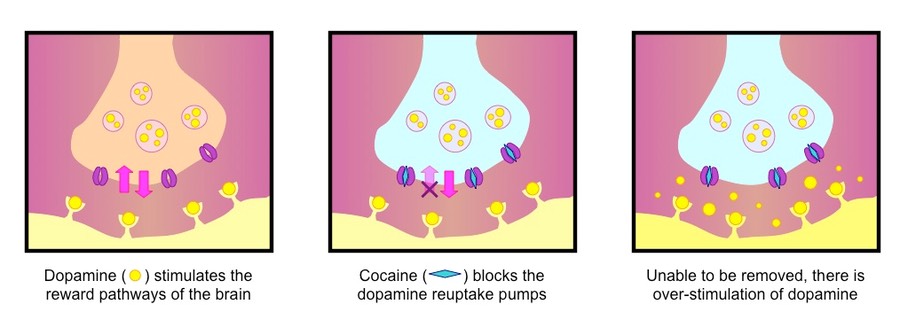E.4.1 State that some presynaptic neurons excite postsynaptic transmissions and others inhibit postsynaptic transmissions
Presynaptic neurons release neurotransmitters into the synapse to create graded potentials in postsynaptic neurons
Some presynaptic neurons generate excitatory postsynaptic potentials (EPSPs) while others generate inhibitory postsynaptic potentials (IPSPs)
If the combination of signals reaches a threshold level, an action potential will be generated in the postsynaptic neuron
E.4.2 Explain how decision making in the CNS can result from the interaction between the activities of excitatory and inhibitory presynaptic neurons at synapses
Decision making in the CNS involves the integration of multiple nerve impulses at various synaptic junctions
Some presynaptic neurons are excitatory (cause depolarisation) while others are inhibitory (cause hyperpolarisation)
Excitatory and inhibitory presynaptic neurons function by releasing different neurotransmitters
The net effect of these signals are generally summative (either spatial or temporal)
Summation can lead to the selection of alternative neuronal pathways in the frontal cortex of the brain involved in decision making processes
Temporal and Spatial Summation

E.4.3 Explain how psychoactive drugs affect the brain and personality by either increasing or decreasing postsynaptic transmissions
Psychoactive drugs may either increase postsynaptic transmission (stimulants) or decrease postsynaptic transmissions (depressants)
Whereas stimulants produce psychomotor arousal and increased alertness, depressants slow down brain activity and relax muscles
Both act primarily on the CNS and can cause a chemical dependency, leading to substance abuse and addictions
Mechanism of Action of Various Psychoactive Drugs

E.4.4 List three examples of excitatory and three examples of inhibitory psychoactive drugs
Excitatory: Cocaine, Amphetamines, Nicotine
Inhibitory: Benzodiazepines, Alcohol, Tetrahydrocannabinol (THC)
![]() Mouse Party
Mouse Party
E.4.5 Explain the effects of THC and cocaine in terms of their action at synapses in the brain
Tetrahydrocannabinol (THC)
Mechanism of Action:
- THC is a psychoactive drug found in the Cannabis plant and is the active component of marijuana
- THC mimics the neurotransmitter anandamide by binding to pre-synaptic cannaboid receptors
- This causes hyperpolarisation of the neuron, preventing neurotransmitter release and hence prevents post-synaptic excitation
Effects:
- Increased sensory intensity of perceived sensory data
- Sense of emotional well-being
- Reduced concentration and impaired judgement of time and space

Cocaine
Mechanism of Action:
- Cocaine acts indirectly on dopamine, which is involved in the brain's reward pathway
- Cocaine blocks the dopamine reuptake pump in the presynaptic terminal
- Consequently, dopamine remains active in the synapse, continuing to bind to postsynaptic receptors and causing excitation
Effects:
- Suppresses appetite and enhances endurance / energy levels
- Sense of euphoria and mellowness
- Long-term use associated with medical complications and severe mental disorders

E.4.6 Discuss the causes of addiction, including genetic predisposition, social factors and dopamine secretion
- Addiction is a dependence on a substance or activity resulting in its repeated and compulsive use
- Stopping is very difficult and can cause severe physical and mental reactions (withdrawal symptoms)
- There are many suggested causes for drug addiction, including:
Genetic Predisposition
- Predisposition may be determined by polygenic inheritance
- Environmental factors (such as social influences) will play a significant role
Social Factors
- Individuals raised in environments with prevalent substance abuse (parental influence or peer pressure) are at a higher risk
- Individuals who have been treated with neglect (child abuse) or suffered significant personal trauma are at a higher risk
- Certain cultures have a higher incidence of addictions (may be genetic or due to demographic influences / marketing)
- Addictive drug use can lead to lower work or school performance and encourage criminal behaviour to fund habit
Dopamine Secretion
- Dopamine is released in response to reward (activates pleasure pathways of the brain)
- Some drugs enhance dopamine activity (e.g. cocaine, heroin)
- Abuse of drugs hypothesized to lead to down-regulation of dopamine receptors, requiring higher doses to achieve same effect (habituation)